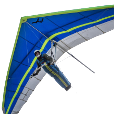No need for trial and error. Add points to the car (block) at the center of the tires and create an arc with a radius of the wheel base centered on the rear wheel (I assume the rear is to the left).
Construct an offset line to the surface profile at a distance equal to the radius of the tires (0.35 in your drawing). Position the center of the rear (left?) tire on the offset line as shown here using osnap nearest.
Set osnap to endpoint, node, intersection and ow give the rotate command and click the center of the rear tire for the Base Point and then enter R and click the center of the rear wheel again and then the center of the front wheel and then click at the intersection of the red arc and the magenta offset line.
This will precisely position the car.
If you do not need precise rotation you can eyeball it!
Here's the result of 4 positionings.
car align to curve.01.dwg



